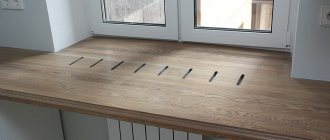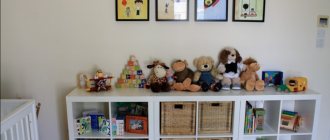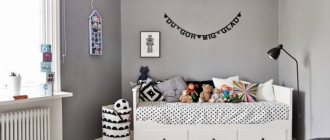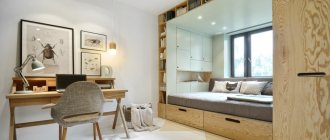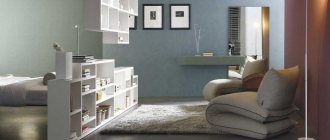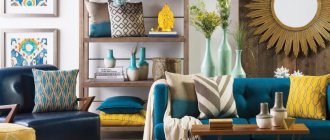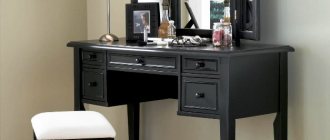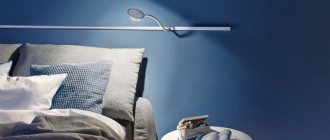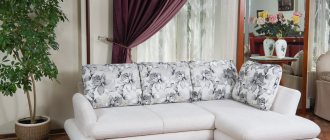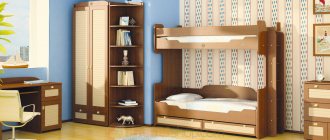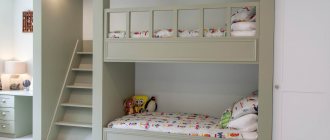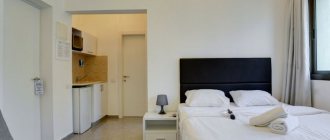In recent years, the popularity of beds consisting of two tiers has increased significantly. The reason for its popularity is simple - it is a practical choice for families with two children and owners of not too large apartments. You can see numerous bunk beds, photos of which will help you find the most practical option. This double bed made of pine or oak will fit perfectly into the interior of a nursery, and your own little house will delight little children. Today there are different models on the market - Flint, Rauta, Provence, a bed house, a ship or a bed equipped with a slide.
Advantages
Advantages
Before you go to the store to purchase such furniture, you need to familiarize yourself with its advantages and disadvantages.
Advantages of 2-tier models:
- space saving - sleeping places are placed vertically, which can significantly reduce the occupied space. Some models have a table, which also helps save space. Examples of such models can be seen in the photo;
- variety of manufacturing materials - furniture is made from pine, oak. Furniture on two floors can be not only wooden, but also metal, and finding it on the modern market is not difficult;
- harmonious combination with the interior - a wooden bed made of oak or pine, and metal upholstered furniture with forged elements will fit perfectly into your own children's house. Provence is perfect for aesthetes, and Flint is perfect for young pirates;
- functionality - there are models designed for one child. On the ground floor there is a table, a loft or it is equipped with drawers. Photos of such products speak about their advantages; some options can be divided into two sleeping areas;
- element of gameplay - a bed can be an element of children's play space. The imagination of designers is very diverse. Based on this, a child's bed may look like a bunk bed, a car, a house or a ship;
- the ability to choose a bed based on gender - there are options only for girls, the aesthetic Provence, or for boys, the Flint variety. There are pieces of furniture without gender division, Rauta, made like a house;
- the presence of a slide or attic - when children are about the same age, they will learn to negotiate in childhood. One child will have to sleep downstairs, and the second will have to occupy the attic. If the latter is equipped with a slide, then it is still unknown what place there will be a fight for.
Bunk beds are used as an example for a toy bed. A bunk bed for dolls will perfectly complement the play space in a girls' room. If you are interested in how to make a two-story bed for dolls, then you are in luck, since it is very easy to assemble such a bed. All you need is cardboard, glue and paint. Such a crib and doll house, together with a normal bed, will help create an excellent bedroom interior for girls.
Ease of installation
Beds with 2 tiers help not only to save on purchasing beds, but also to properly organize all the space in the children's room. They also solve the problem of storing children's supplies and organizing play space.
Advice. Having children together in a limited space benefits their psychological development. This is how they learn to negotiate and take into account each other’s interests.
However, this furniture also has disadvantages. However, there are significantly fewer of them:
- Injury hazard: there is a possibility of falling from the upper tier.
- Inconvenient stairs. It is not always convenient to climb on it, for example, if children are sick.
The main disadvantage of a double bed is the need to climb up to sleep. This may not always be convenient, for example, for reading a fairy tale to a child or caring for him during illness.
Flaws
Flaws
And although such furniture has a lot of advantages, there are also disadvantages:
- height is the main drawback of the bed; it is noticeable even in the photo. Such samples are tall, which can cause inconvenience. The attic is equipped with sides; it is not suitable for all children; the child may not agree to sleep there. And although the bed is equipped with a side, children can still fall off it while playing;
- poor air movement - the air at the height of the upper bunks is drier and hotter. The attic will heat up and sleep there will be uncomfortable. This rule applies to all beds, even Provence and Flint styles. A house bed, instead of a safe refuge, can turn into a health hazard due to stuffiness;
- Psychological factors - from a psychological point of view, choosing a place to sleep can negatively affect children. A child sleeping on the top bunk develops a sense of arrogance. Those who sleep on the bottom bunk, on the contrary, may feel depressed. But the correct actions of parents neutralize this shortcoming;
- technical factors - children occupying lower places often complain of squeaks if the shelves are made of wood. They are unusual in seeing such a low ceiling, which can lead to negative feelings;
- poor quality of parts - the presence of low-quality working parts in some models can affect the service life.
What types are there?
It was previously noted that such furniture comes in different types. These types of beds can be distinguished.
Depending on the number of beds, this could be:
- classic bed for two beds - the beds are located vertically relative to each other (Flint, Provence variety). Shelves can be the same or different sizes;
- bed with one bed - ideal for families with one child. The bed is placed on the lower or upper floor. The space under the bed can be used as a playhouse or workspace;
- a three-seater model with two tiers - or a bunk bed for adults, has a lower double bed, for example, the Rout model, or an additional bed extends out of it, which can be seen in the photo.
Classic bed on two floors
Model with work area and one berth
Two-tier model for three
Depending on the material of manufacture, this can be:
- metal construction is strong and durable, but expensive. There are certain restrictions in the design of such beds, which reduces their variety;
- wooden bed - has good strength and elegant appearance. Can be made from pine, oak or other types of wood. Sudden changes in temperature and high levels of humidity can negatively affect the bed, so these characteristics must be constantly monitored;
- models made of chipboard/MDF are low in cost. Conventional products have the necessary strength, but the use of poor, “loose” materials can significantly reduce their service life. There are multi-color models, for example, the Rainbow bunk bed, and models made in one color, for example, white upholstered furniture, green or red.
Metal model on two floors
Wooden two-level model
Two-level bed made of chipboard
Depending on the functionality, it can be:
- a bed with places where the child can store his things - equipped with drawers and a built-in or attached wardrobe;
- a bed with a place for studying - having a table on the lower tier. Above the table there can be shelves in which the child will store school supplies;
- option with tools for physical exercises - can be equipped with a wall bars, horizontal bar, rope, slide;
- furniture with a games room - the first floor is made in the form of a games house, or a small games room;
With shelves for things
With work area and bed on the second floor
Sports corner with bed on the second floor
A playhouse based on a two-level bed.
Depending on the placement of shelves relative to one element to another, it can be:
- classic double design with beds placed one above the other;
- a bed in which the beds are offset along the horizontal axis. The space under the top shelf can be equipped with a cabinet;
- bed with perpendicular placement of shelves.
Classic sleeping arrangements
With staggered beds
With perpendicular sleeping places
There are types of beds that do not fit into the general classification. The following models fall into this category:
- pull-out and roll-out beds - they are not high, since the sleeping places are placed directly above each other;
- transformable bed - with the help of working parts, the bed can become a sofa or other type of furniture;
- corner options - a corner bed is placed in the corner of the room and can be equipped with drawers or contain a wardrobe or table;
- A loft bed is a good choice for children who like to climb higher. Upstairs there is an attic with a bunk. It is easy to place a table under it, or equip the free space with drawers and a cabinet. Such models are suitable for both children and teenagers or even adults. A child can use such a bed for games, imagining that the free lower space is his house, or a ship. If the attic is equipped with a slide, then this is an additional place for games.
Pull-out bed model
Two-level transformable bed with sofa
Corner bed on two floors
Children's loft bed with slide and ladder
Design examples of bunk beds
Photo of the design of two-tier structures.
Bed-bus
It provides not only a cozy place to sleep, but also for active games. A bus bed can come in a huge variety of different designs, such as a school bus or fantasy cartoon models.
Car bed
Sometimes a car bed is equipped with lighting, drawers, shelves and other elements. Such models have both open and closed versions with windows and doors.
House
This product has a truly fabulous, unusual look and radically changes the environment of the nursery, both boys and girls.
In the form of a ship
A ship bed equipped with movable anchors, ropes, a rotating helm, lowering and rising sails, a real pirate flag or other special details will make spending time in the nursery even more interesting and exciting.
Forged
They are distinguished by a strong frame and reliable sides that ensure safe sleep for the child. In addition, these iron products can have a more laconic design or be made with elements of artistic forging with amazing curls and patterns.
The photo shows a black wrought-iron bunk bed in a Scandinavian-style children's interior.
With canopy
Thanks to such a spectacular addition as a canopy, it is possible to give the nursery’s interior a special charm and create a secluded, cozy and calm atmosphere.
In the form of a castle
Most often, a castle bed is used to decorate a girls’ room. This design has special stairs, high towers and playgrounds that will create an ideal sleeping area for little princesses.
With drawings
They will become a real interior decoration and will add a certain mood and originality to the nursery environment.
Corner models
Standard models of bunk beds involve placing the beds in one vertical line. Such beds include Flint models. But a few years ago, products appeared that, when positioned correctly, help save space even more. We are talking about corner bunk beds made of pine, oak and other types of wood. Their main feature is that the bottom shelf and attic of such models are placed perpendicularly. Moreover, they are connected to different walls.
The corner model, as already mentioned, is made of pine, oak materials or other types of wood. A simple staircase or steps can lead to the second floor. Some models are equipped with drawers. You can find specimens equipped with a slide. Interestingly, this type of bed is suitable for both younger children and teenagers.
Due to the fact that the 2 bunk loft beds only partially cover the bottom shelf, the space underneath can be used for other furniture. It’s easy to place a table here, equip the space with drawers or a cabinet. Children can use this space as a playhouse. If the layout of the nursery allows it, the model can be placed in the corner, with a table in the center, making optimal use of the living space. In the photo you can see how this affects the interior of the room.
It is worth noting that instructions are provided for such samples, but assembling them yourself is quite difficult. Workers may have to be brought in.
With withdrawable mechanism
Another new feature is a roll-out bed. It is distinguished from the standard version by its small height. In such options, the beds are placed directly above each other, without any clearance, as can be seen in the photo. If necessary, the lower, pull-out shelf rolls out. The model is foldable, after sleep the lower bed is folded back. By placing a table next to it, the bedroom can be turned into a living room.
When folded, the model resembles a couch. It can be used as a sofa. This gives the model functionality. For obvious reasons, it is impossible to equip such beds with drawers, like a wardrobe. Most of these beds are double. But you can also find samples designed for three people. In this case, there will be one more bunk on top above the bottom bunks. These beds are made mainly from wood. Products made from pine and oak are often found. The metal pull-out bed is not so popular due to its increased weight.
A roll-out bed also has disadvantages. The main disadvantage is that the retractable part returns to its folded state after sleep. If the child wants to lie down on it to rest, the products will have to be laid out again. Children love to share territory, and a pull-out bed can lead to arguments.
The folding model is well suited for those who need compact furniture. They do not require ladders and are not equipped with sides. The low height of the top shelf will prevent the child from being injured when falling. Children can play with such furniture, using it as a ship or a car. In the photos presented, such models look great.
Colors of children's 2-level beds
Decorating a girl's bedroom mainly involves lilac, pink, pale yellow or other soft pastel shades. For a boy's nursery, blue, blue, green, light green, or orange colors are often chosen. The universal white model will look equally good in the room of a child of any gender and age.
The photo shows a children's room for girls with a pink bunk bed.
When choosing a color, first of all, take into account the color scheme of the entire room. A bunk bed should have a color combination with the overall tone of the decor or with some furniture and decorative elements.
Options with sofa
A good option for small spaces is a bed with a sofa. This type of furniture allows you to turn a children's room or bedroom into a living room. The attached instructions will help you do this. This type of furniture is also suitable for teenagers. You can put a table next to it.
The bed in such furniture occupies the attic. There is a sofa downstairs. It can be folded, turning into another bed or remaining static. The second case is suitable for families with one child. The main advantage of such models is the ability to equip one room with a bed and a sofa and save even more space, which is not always possible when separated. One of the varieties of such furniture is a bed with a Eurobook sofa. This is a retractable model. It is more practical because it is equipped with small drawers.
The main advantage is also the main disadvantage. While the child’s spine is developing, it is not recommended for him to sleep on the sofa. For older children, it is more rational to equip the lower space with a table.
As in previous cases, such beds are also made of wood. Pine and oak make durable and pleasant-to-touch frames. But the metal model is no less popular.
What are the best materials?
As with regular beds, different materials are used to produce bunk models:
- solid natural wood: pine, oak (for Provence beds);
- Chipboard and MDF (for Flint beds);
- metal and forged samples (for example, the metal model of Rout);
- plastic.
When choosing beds, parents are guided by their price characteristics. But, at the same time, do not forget about the material of manufacture. In financial terms, the most profitable will be bunk beds made of chipboard (Flint model) or plastic. These materials are not the healthiest for the child's health. For the production of chipboards, formaldehyde resins are used. When heated, formaldehyde is released from such beds. It is harmful to children's health.
The strongest beds are those with a metal base. Some forged samples look like objects of art, as can be seen from the photo. But a metal bed may look too bulky. In addition, these are heavy models and in case of an accident they can cause harm to the child. Metal furniture does not heat up well and is not very pleasant to the touch, which can bring discomfort to the child.
A bunk bed made of solid oak, pine or other type of wood has many advantages. This double bed is a very strong model, especially if it is made of oak, for example, the Provence model. It retains its appearance for a long time and is absolutely harmless to the child. Metal must be used for working elements. If furniture is intended for children, it should be made exclusively from natural ingredients.
Wooden bunk bed model
Two-level model for three on a metal frame
MDF bed
Chipboard model
Solid oak bed
How are the sleeping arrangements arranged?
Dimensions
In stores you can find a large number of beds with different sizes. The following standard groups are usually distinguished.
- 700×1500 (1600) mm. These beds are designed for babies. What you need to choose here is not so much the size, but how much ease of use.
- 800 (900) x1900 mm. This type of furniture is intended for teenagers, although it can also be used by adults.
- 90×2000 mm. The size is suitable for adults. Although it can also be used by teenagers.
In general, when choosing furniture for children, you should not buy very small beds. Children will grow up quickly, and you will have to buy a new bed that is suitable for their height. When choosing, always look at the size.
Base
It is also advisable to know in advance what types of bunk beds there are based on the base material. There are two types.
- Lamels. These are thin planks made of wood or plastic. They belong to the orthopedic type. They provide good ventilation of the mattress, which is especially important if a child uses the bed.
- Solid base. It is a shield made of plywood. This form is usually used in transformable beds. Disadvantage: poor ventilation of the mattress.
When purchasing, evaluate the quality of the base; it is best to use lamellas, they are more reliable and comfortable.
Mattress
Mattresses are not included and must be purchased separately. When choosing, you should consider who will use it: an adult, a teenager or a child. You should choose a sofa based on the requirements of a particular person.
- Orthopedic. They have a certain degree of rigidity. Perform the function of supporting the spine.
- Anatomical. Takes the shape of the body. For most people this is the best option.
When buying for a child, the quality of the mattress should be assessed by parents. Have your child lie down on the product. If the shoulders and hips sink, and the back and legs lie “on the surface”, the rigidity is ideal.
Knowing how to choose a bunk bed, you can choose this furniture most accurately and without mistakes. Be sure to take into account all the nuances that may affect the operating features.
The safest models
There are several nuances that affect the safety of beds:
- height - falling from a great height, especially onto a table or other objects, can cause injury to a child. In this regard, a loft bed is a bad choice. A pull-out bed made of oak, on the contrary, will protect your baby’s sleep. If the choice was a standard model, then the upper tier must be equipped with sides;
- staircase - for children, the best option would be furniture with steps. They can be equipped with drawers or a cabinet;
- sharp corners - they must be avoided as they are dangerous. The same applies to all bolts, paper clips and working parts. If the model has a table, it should also have no sharp corners;
- distance between shelves - if there is not enough space, children can get injured while sleeping or playing.
All things considered, a trundle bunk bed is the safest model for children, especially if you have younger children.
How to choose the size of a bunk bed depending on the age of the child
Generally accepted standard sizes will help you easily choose the right parameters for your age. But it should be taken into account that not all children have a height corresponding to their age. If everything is fine with this, you can safely choose the size of the sleeping place according to the following criteria:
- 0–3 years. At this age, 120 by 65 centimeters is ideal;
- 3–5 years. The baby will be comfortable in a sleeping place 140 by 75 centimeters;
- 5–7 years. The most convenient size would be 160 by 75 centimeters;
- 7–13 years old. Here the bed parameters are already close to adults - 190 by 80 centimeters.
All these parameters are only approximate. You need to understand that some children grow faster, others slower. The quality of their sleep, and, consequently, their health, as well as their academic performance, will depend on the right choice of bunk bed.
